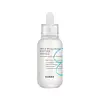What's inside
What's inside
 Key Ingredients
Key Ingredients

 Benefits
Benefits

 Concerns
Concerns

No concerns
 Ingredients Side-by-side
Ingredients Side-by-side

Niacinamide 2%
SmoothingAdenosine 0.04%
Skin ConditioningWater
Skin ConditioningDipropylene Glycol
HumectantButylene Glycol
HumectantGlycereth-26
HumectantGlycerin
HumectantBetaine
HumectantPhytosterols
Skin ConditioningCeramide NP
Skin ConditioningSqualane
EmollientLauric Acid
CleansingArachidic Acid
CleansingBehenic Acid
CleansingBeta-Glucan
Skin ConditioningPaulownia Tomentosa Leaf Extract
AstringentCinnamomum Cassia Bark Extract
MaskingCinnamomum Japonicum Leaf Extract
AntioxidantCinnamomum Camphora Leaf Extract
MaskingLaurus Nobilis Leaf Extract
MaskingCoriandrum Sativum Extract
Skin ConditioningEucalyptus Globulus Leaf Extract
PerfumingScutellaria Baicalensis Root Extract
AstringentMachilus Thunbergii Branch Extract
Skin Conditioning1,2-Hexanediol
Skin ConditioningPolyglyceryl-10 Laurate
Skin ConditioningPolyglyceryl-10 Myristate
Skin ConditioningHydroxyacetophenone
AntioxidantPanthenol
Skin ConditioningDisodium EDTA
Sodium Hyaluronate
HumectantXanthan Gum
EmulsifyingSodium Polyacrylate
AbsorbentEthylhexylglycerin
Skin ConditioningCitrus Aurantium Bergamia Fruit Oil
MaskingLavandula Hybrida Oil
EmollientCitrus Aurantium Dulcis Peel Oil
MaskingLavandula Angustifolia Oil
MaskingAmyris Balsamifera Bark Oil
MaskingOcimum Basilicum Oil
MaskingLimonene
PerfumingLinalool
PerfumingNiacinamide 2%, Adenosine 0.04%, Water, Dipropylene Glycol, Butylene Glycol, Glycereth-26, Glycerin, Betaine, Phytosterols, Ceramide NP, Squalane, Lauric Acid, Arachidic Acid, Behenic Acid, Beta-Glucan, Paulownia Tomentosa Leaf Extract, Cinnamomum Cassia Bark Extract, Cinnamomum Japonicum Leaf Extract, Cinnamomum Camphora Leaf Extract, Laurus Nobilis Leaf Extract, Coriandrum Sativum Extract, Eucalyptus Globulus Leaf Extract, Scutellaria Baicalensis Root Extract, Machilus Thunbergii Branch Extract, 1,2-Hexanediol, Polyglyceryl-10 Laurate, Polyglyceryl-10 Myristate, Hydroxyacetophenone, Panthenol, Disodium EDTA, Sodium Hyaluronate, Xanthan Gum, Sodium Polyacrylate, Ethylhexylglycerin, Citrus Aurantium Bergamia Fruit Oil, Lavandula Hybrida Oil, Citrus Aurantium Dulcis Peel Oil, Lavandula Angustifolia Oil, Amyris Balsamifera Bark Oil, Ocimum Basilicum Oil, Limonene, Linalool
Water
Skin ConditioningGlycerin
HumectantButylene Glycol
HumectantDipropylene Glycol
Humectant1,2-Hexanediol
Skin ConditioningMethyl Gluceth-10
EmulsifyingSodium Hyaluronate
HumectantCarbomer
Emulsion StabilisingPanthenol
Skin ConditioningTromethamine
BufferingEthylhexylglycerin
Skin ConditioningHyaluronic Acid
HumectantHydrolyzed Hyaluronic Acid
HumectantGluconolactone
Skin ConditioningLactobionic Acid
Buffering
 Reviews
Reviews

Ingredients Explained
These ingredients are found in both products.
Ingredients higher up in an ingredient list are typically present in a larger amount.
1,2-Hexanediol is a synthetic liquid and another multi-functional powerhouse.
It is a:
- Humectant, drawing moisture into the skin
- Emollient, helping to soften skin
- Solvent, dispersing and stabilizing formulas
- Preservative booster, enhancing the antimicrobial activity of other preservatives
Butylene Glycol (or BG) is used within cosmetic products for a few different reasons:
Overall, Butylene Glycol is a safe and well-rounded ingredient that works well with other ingredients.
Though this ingredient works well with most skin types, some people with sensitive skin may experience a reaction such as allergic rashes, closed comedones, or itchiness.
Learn more about Butylene GlycolDipropylene Glycol is a synthetically created humectant, stabilizer, and solvent.
This ingredient helps:
Dipropylene glycol is technically an alcohol, but it belongs to the glycol family (often considered part of the ‘good’ alcohols). This means it is hydrating and gentle on skin unlike drying solvent alcohols like denatured alcohol.
As a masking agent, Dipropylene Glycol can be used to cover the smell of other ingredients. However, it does not have a scent.
Studies show Dipropylene Glycol is considered safe to use in skincare.
Learn more about Dipropylene GlycolEthylhexylglycerin (we can't pronounce this either) is commonly used as a preservative and skin softener. It is derived from glyceryl.
You might see Ethylhexylglycerin often paired with other preservatives such as phenoxyethanol. Ethylhexylglycerin has been found to increase the effectiveness of these other preservatives.
Glycerin is already naturally found in your skin. It helps moisturize and protect your skin.
A study from 2016 found glycerin to be more effective as a humectant than AHAs and hyaluronic acid.
As a humectant, it helps the skin stay hydrated by pulling moisture to your skin. The low molecular weight of glycerin allows it to pull moisture into the deeper layers of your skin.
Hydrated skin improves your skin barrier; Your skin barrier helps protect against irritants and bacteria.
Glycerin has also been found to have antimicrobial and antiviral properties. Due to these properties, glycerin is often used in wound and burn treatments.
In cosmetics, glycerin is usually derived from plants such as soybean or palm. However, it can also be sourced from animals, such as tallow or animal fat.
This ingredient is organic, colorless, odorless, and non-toxic.
Glycerin is the name for this ingredient in American English. British English uses Glycerol/Glycerine.
Learn more about GlycerinPanthenol is a common ingredient that helps hydrate and soothe the skin. It is found naturally in our skin and hair.
There are two forms of panthenol: D and L.
D-panthenol is also known as dexpanthenol. Most cosmetics use dexpanthenol or a mixture of D and L-panthenol.
Panthenol is famous due to its ability to go deeper into the skin's layers. Using this ingredient has numerous pros (and no cons):
Like hyaluronic acid, panthenol is a humectant. Humectants are able to bind and hold large amounts of water to keep skin hydrated.
This ingredient works well for wound healing. It works by increasing tissue in the wound and helps close open wounds.
Once oxidized, panthenol converts to pantothenic acid. Panthothenic acid is found in all living cells.
This ingredient is also referred to as pro-vitamin B5.
Learn more about PanthenolSodium Hyaluronate is hyaluronic acid's salt form. It is commonly derived from the sodium salt of hyaluronic acid.
Like hyaluronic acid, it is great at holding water and acts as a humectant. This makes it a great skin hydrating ingredient.
Sodium Hyaluronate is naturally occurring in our bodies and is mostly found in eye fluid and joints.
These are some other common types of Hyaluronic Acid:
Learn more about Sodium HyaluronateWater. It's the most common cosmetic ingredient of all. You'll usually see it at the top of ingredient lists, meaning that it makes up the largest part of the product.
So why is it so popular? Water most often acts as a solvent - this means that it helps dissolve other ingredients into the formulation.
You'll also recognize water as that liquid we all need to stay alive. If you see this, drink a glass of water. Stay hydrated!
Learn more about Water